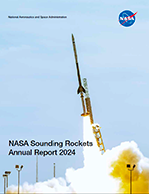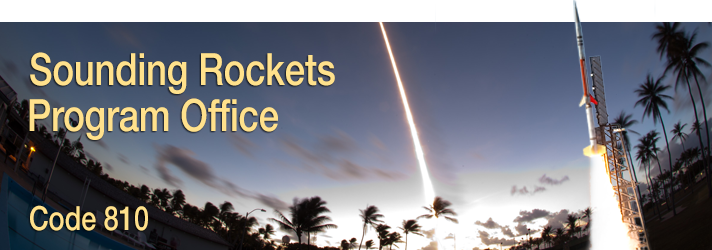
News
 B-SPICE Team with rocket at White Sands Missile Range, NM. WSMR Photo.
B-SPICE Team with rocket at White Sands Missile Range, NM. WSMR Photo.
36.382 UE GILCHRIST/UNIVERSITY OF MICHIGAN
November 23, 2024
Beam-Spacecraft Plasma Interaction and Charging Experiment (B-SPICE)
36.382 UE Terrier-Black Brant sounding rocket waslaunched from White Sands Missile Range, NM on November 23, 2024.The Beam-Spacecraft Plasma Interaction and Charging Experiment (B-SPICE) is a tethered rocket experiment, dedicated to investigate the mitigation of spacecraft charging induced by an electron beam using a plasma contactor. The experiment studied ion current production, plasma plume expansion, and expellant utilization in relation to mitigation effectiveness to understand how the system may scale for magnetospheric experiments. Successful completion of this experiment will raise the technological readiness level (TRL) of the described spacecraft-charging mitigation scheme for application to active experiments in the low-density magnetosphere.
 One of the VortEx rockets launches from Andoya, Norway. NASA Photo/Garon Clark.
One of the VortEx rockets launches from Andoya, Norway. NASA Photo/Garon Clark.
36.362 & 41.128 UE LEHMACHER/CLEMSON UNIVERSITY
November 10, 2024
Vorticity Experiment - VortEx
36.362 UE Terrier-Black Brant and 41.128 UE Terrier-Improved Orion sounding rockets were launched from Andoya, Norway on November 10, 2024.This was the second salvo of the VortEx experiments with the science objective to better understand nonlinear gravity wave interactions in the upper mesosphere and lower thermosphere, ther formation of vortices, and the importance of mesoscale stratified turbulence.
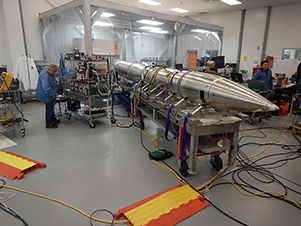 FURST payload testing att White Sands Missile Range, NM.
FURST payload testing att White Sands Missile Range, NM.
36.366 US KANKELBORG/MONTANA STATE UNIV.
September 3, 2024
Full-Sun Ultraviolet Rocket SpecTrograph (FURST)
36.366 US Terrier-Black Brant sounding rocket was launched from White Sands Missile Range, NM on September 3, 2024.This was the first flight of the Full disk Ultraviolet Rocket SpecTrometer (FURST) experiment. FURST is a new experiment that takes advantage of heritage experiment elements and experience to characterize the Far Ultraviolet (FUV) spectrum of the “Sun as a Star.” Compared to other stars such α Centauri A, the FUV spectrum of our Sun is relatively unknown and this mission plans to expand that knowledge.
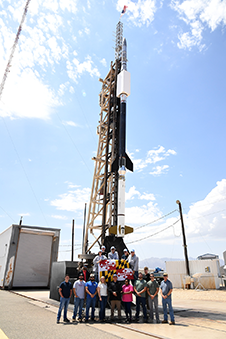 OAxFORTIS team with rocket at White Sands Missile Range, NM.
OAxFORTIS team with rocket at White Sands Missile Range, NM.
36.384 UG McCANDLISS/JOHNS HOPKINS
August 25, 2024
Off-Axis Far-Ultraviolet Off-Rowland Telescope for Imaging and Spectroscopy (OAxFORTIS)
36.384 UG Terrier-Black Brant sounding rocket was launched from White Sands Missile Range, NM on August 25, 2024.This was the fifth flight of the Far-ultraviolet Off Rowland-circle Telescope for Imaging and Spectroscopy (FORTIS) experiment, now reconfigured in an Off-Axis configuration (OAxFORTIS). The objective of this flight was to acquire far-UV spectra of the globular cluster Messier 10 (M10). M10 is located in the equatorial constellation of Ophiuchus.
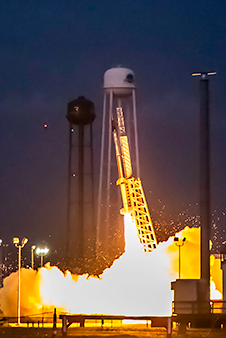 RockSat-X sounding rocket launching. Credit:NASA Photo/Berit Bland.
RockSat-X sounding rocket launching. Credit:NASA Photo/Berit Bland.
46.042 WO KOEHLER/NASA WFF
August 13, 2024
RockSat-X
46.042 WO Terrier-Improved Malemutet sounding rocket was launched from Wallops Island, VA on August 13, 2024. The primary objective of RockSat-X is to offer undergraduate student teams the opportunity to design and build unique experiments that will fly onboard a rocket borne carrier that provides full exposure to the space environment. This opens the range of investigations that can be conducted and is a logical step forward towards fostering the development of future space scientists and engineers.
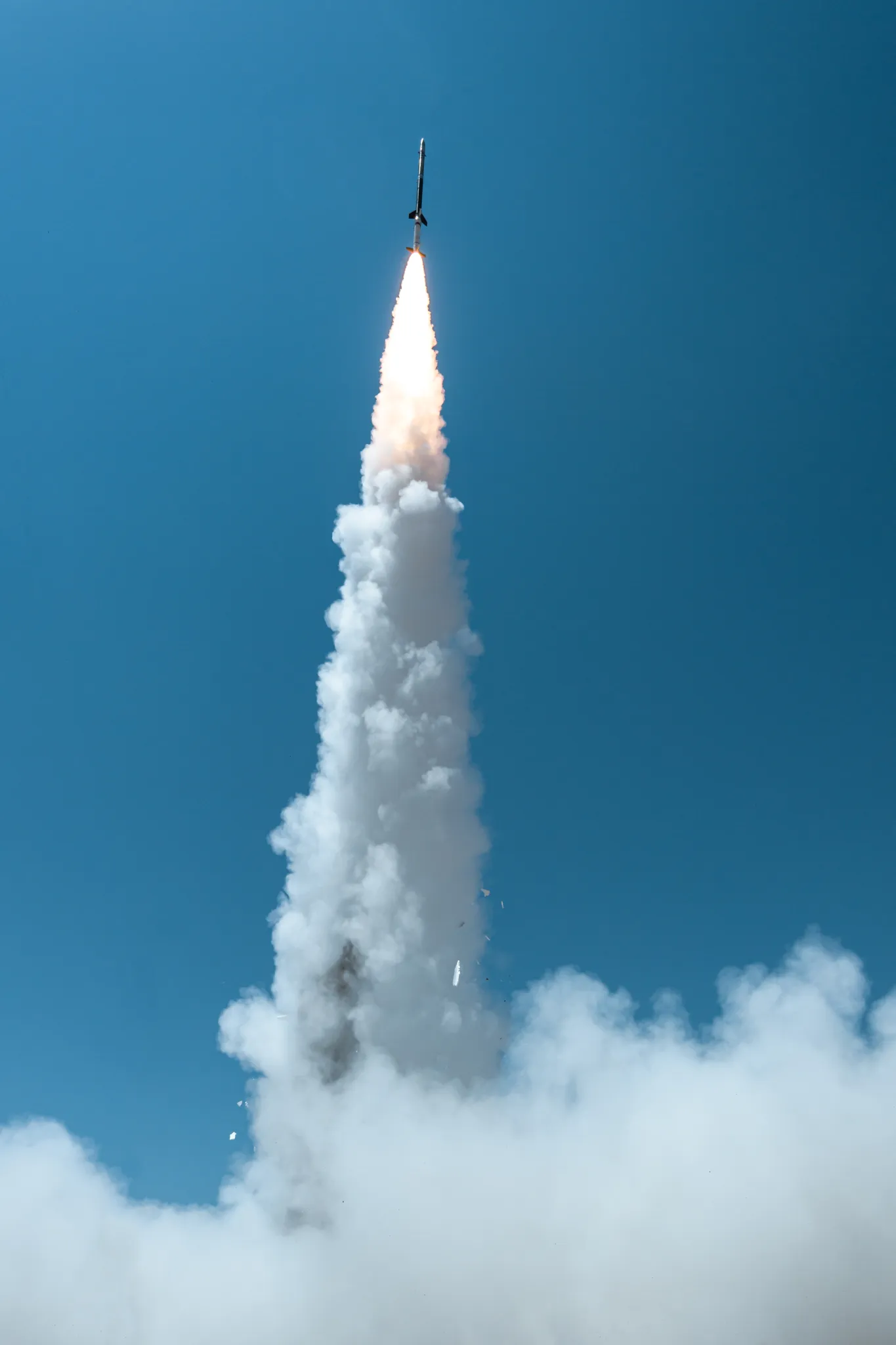 MaGIXS-2 sounding rocket launching. Credit: United States Navy.
MaGIXS-2 sounding rocket launching. Credit: United States Navy.
36.385 NS WINEBARGER/NASA MSFC
July 16, 2024
Marshall Grazing Incidence X-ray Spectrometer (MaGIXS) 2
36.385 NS Terrier-Black Brant sounding rocket was launched from White Sands Missile Range, NM on July 16, 2024. The mission’s goal is to determine the heating mechanisms in active regions on the Sun by making critical observations using X-ray spectroscopy.
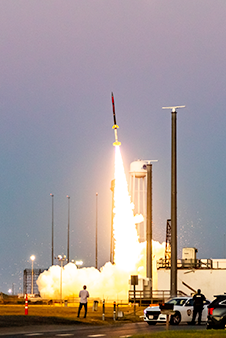 RockOn launches from Wallops Island, VA. Credit: NASA Photo/Berit Bland.
RockOn launches from Wallops Island, VA. Credit: NASA Photo/Berit Bland.41.133 WO KOEHLER/NASA WFF
June 20, 2024
RockOn
41.133 WO Terrier-Improved Orion sounding rocket was launched from Wallops Island, Va on June 20, 2024.This mission carries two types of student experiments, RockOn experiments and RockSat-C experiments. The RockOn experiments are built, tested and integrated by University students and faculty attending the week long workshop held at Wallops starting on June 15th.
The RockSat-C experiments are more advanced and are built by teams of students prior to arrival at Wallops. Payload support systems are similar to RockOn experiments.
In 2024 five canisters carry workshop experiments, and three canisters carry RockSat-C experiments. Five Universities and Cubes-in-Space are providing RockSat-C experiments.
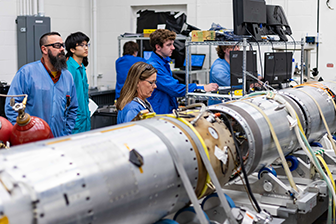 CIBER integration at Wallops..
CIBER integration at Wallops.. 36.396 UG ZEMCOV/RIT
May 5, 2024
Cosmic Infrared Background ExpeRiment (CIBER) 2
36.396 UG Terrier-Black Brant sounding rocket was launched from White Sands Missile Range, NM, on May 5, 2024.CIBER 2 investigated the spectral and spatial properties of the extragalactic near-infrared background and required acquisition of multiple targets with minimum contamination from terrestrial sources of infrared emission
36.371 NS SAVAGE/NASA MARSHALL SPACE FLIGTH CENTER
April 17, 2024
Hi-C Flare (High resolution Coronal imager solar Flare)
36.371 NS Terrier-Black Brant sounding rocket was launched from Poker Flat Reserch Range on May 17, 2024. The science goals of the Hi-C Flare experiment is to determine 1) the mechanisms that drive continual heating of flares into the decay phase, 2) how energy is transferred from the corona to the chromosphere during flares, and 3) the morphology of the source regions associated with particles that are accelerated into the heliosphere. 36.371 Savage is a refly of 36.342 Winebarger with some new hardware and component-level modifications, and was the fourth flight of the Hi-C instrument.
36.370 US GLESENER/UNIVERSITY OF MINNESOTA
April 17, 2024
FOXSI-4 (Focusing Optics X-ray Solar Imager)
36.370 US Terrier-Black Brant sounding rocket was launched from Poker Flat Reserch Range on May 17, 2024. The Focusing Optics X-ray Solar Imager payload (FOXSI) has flown previously as36.255, 36.295, and 36.325. The science objective of 36.370 was to develop an instrument that studies hard and soft X-raysusing direct focusing optics, and to advance toward understanding the high-energy aspects of solar flares.
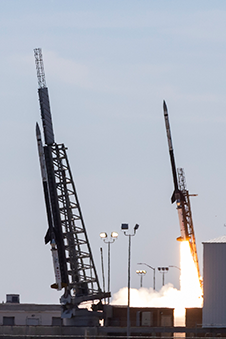 The first APEP-2 rocket takes off.. Credit: NASA Photo/Berit Bland.
The first APEP-2 rocket takes off.. Credit: NASA Photo/Berit Bland.36.392, 393, 394 UE BARJATYA/EMBRY-RIDDLE
April 8, 2024
Atmospheric Perturbations around Eclipse Path (APEP)
36.392, 36.393, 36.394 UE Black Brant IX sounding rockets were launched from Wallops Island, Va on April 8, 2024.The APEP-2 rockets aimed to collect data to answer the following science questions:
Does the eclipse shadow directly seed discernible irregularities in the mid-latitude ionosphere? What are the associated vertical length and time scales of these irregularities?
What are the impacts of the Temperature Gradient Instability (TGI) and Gradient Drift Instability (GDI) in seeding small scale (10s to 100s of meters) ionospheric irregularities in the presence of solar eclipse? How do the various regions of the ionosphere behave differently at small scales in response to the overall cooling effect of the thermosphere?
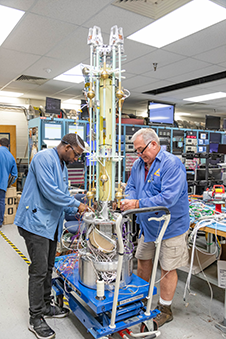 Beam-PIE integration at Wallops. Credit: NASA Photo/Berit Bland.
Beam-PIE integration at Wallops. Credit: NASA Photo/Berit Bland.52.009 AE REEVES/LOS ALAMOS NATIONAL LABORATORY
November 9, 2023
Beam-Plasma Interactions Experiment (Beam-PIE)
52.009 AE Black Brant XII-A sounding rocket was launched from Poker Flat Research Range, AK on November 9, 2023.The purpose of the Beam PIE experiment iwas to use an electron beam to generate VLF radio waves, detect the resulting radio waves using electric field antennas on a separate receiver payload and to measure ambient plasma conditions and dependence of waves on those conditions.
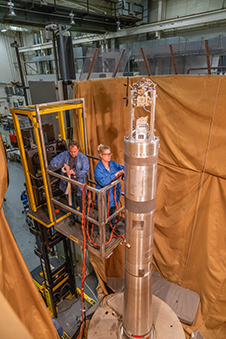 DISSIPATION payload in the deployment facility. Credit: NASA Photo/Berit Bland.
DISSIPATION payload in the deployment facility. Credit: NASA Photo/Berit Bland.45.007 GE BENNA/NASA GSFC
November 8, 2023
DISSIPATION
45.007 GE Terrier-Oriole sounding rocket was launched from Poker Flat Research Range, AK on November 8, 2023.The DISSIPATION experiment provided, for the first time, comprehensive and concurrent in-situ measurements of the response of the thermosphere to Joule heating in the auroral transition region. Most of the knowledge of this dissipati ve process is based on remote and/or limited observations of neutral gas and plasma parameters. DISSIPATION is designed to provide more direct observations.
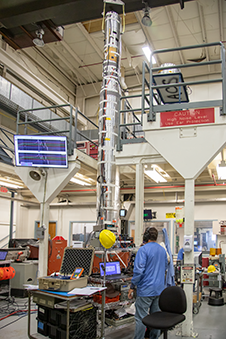 INFUSE on the vibration table at Wallops. Credit: NASA Photo/Berit Bland.
INFUSE on the vibration table at Wallops. Credit: NASA Photo/Berit Bland.36.375 UG FLEMING/UNIVERSITY OF COLORADO
October 29, 2023
Integral Field Ultraviolet Spectroscopic Experiment (INFUSE)
36.375 UG Black Brant IX sounding rocket was launched from White Sands Missile Range, NM on October 29, 2023. INFUSE is a new ultraviolet instrument from the University of Colorado. It is a far-UV integral field spectrograph comprised of a 0.49m Cassegrain telescope.The purpose of INFUSE was to study shock fronts in supernova remnants and to observe the transition, traced in the far-UV, from non-radiative to radiative shocks as material from the supernova begins to interact with the ambient interstellar medium.
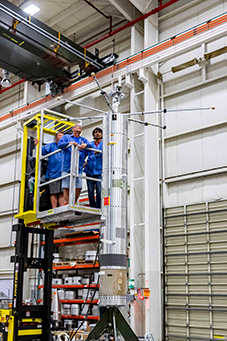 One of the APEP payloads after boom deployment testing. Credit: NASA Photo/Berit Bland.
One of the APEP payloads after boom deployment testing. Credit: NASA Photo/Berit Bland.36.386, 36.387, 36.388 UE BARJATYA/EMBRY-RIDDLE UNIVERSITY
October 14, 2023
Atmospheric Perturbations around Eclipse Path (APEP)
36.386, 36.387, 36.388 UE Black Brant IX sounding rockets were launched from White Sands Missile Range, NM on October 14, 2023. APEP was designed to study the dynamics of Earth’s ionosphere during the Annular Solar Eclipse on October 14, 2023. Three Black Brant IX sounding rockets were launched study the ionosphere before, during, and after the peak eclipse.
 RockOn integration. Credit: NASA Photo/Berit Bland.
RockOn integration. Credit: NASA Photo/Berit Bland.41.132 UO KOEHLER/COLORADO SPACE GRANT
August 17, 2023
RockOn!
41.032 UO Terrier-Improved Orion sounding rocket was launched from Wallops Island, VA on August 17, 2023. The purpose of the RockOn mission is to provide university undergraduate level students and instructors with a space flight opportunity that involves minimal cost, minimal time investment, minimal complexity, and minimal impact on the NASA Sounding Rockets Program. The mission is intended to be an introductory flight opportunity to provide exposure to, and spark interest in, space-based science missions.
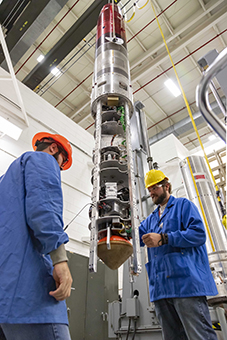 RockSat-X experiment integration. Credit: NASA Photo/Berit Bland.
RockSat-X experiment integration. Credit: NASA Photo/Berit Bland.46.038 UO KOEHLER/UNIVERITY OF COLORADO
August 16, 2023
RockSat-X
46.038 UO Terrier-Improved Malemute sounding rocket was launched from Wallops Island, VA on August 16, 2023. The primary objective of RockSat-X is to offer undergraduate student teams the opportunity to design and build unique experiments that will fly onboard a rocket borne carrier that provides full exposure to the space environment. This opens the range of investigations that can be conducted and is a logical step forward towards fostering the development of future space scientists and engineers.
36.389 US WOODS/UNIVERSITY OF COLORADO
May 3, 2023
SDO EVE Underflight Calibration Experiment
36.389 US Terrier-Black Brant sounding rocket was launched from White Sands Missile Range, NM on May 3, 2023. The primary objective for this mission was to provide an underflight calibration for the EUV Variability Experiment (EVE) aboard the NASA Solar Dynamics Observatory (SDO) satellite.
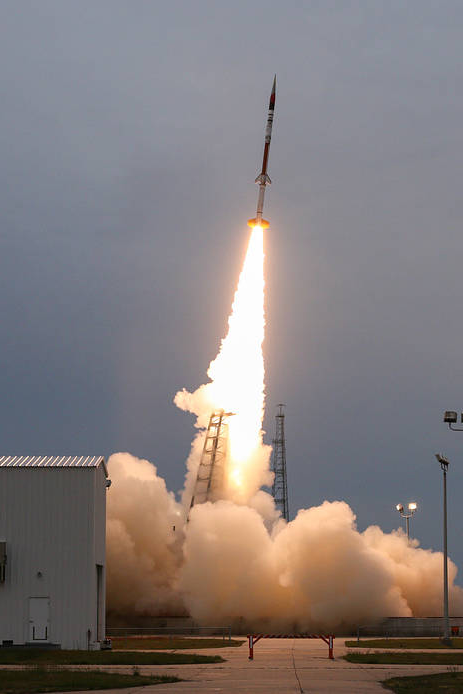 SubTEC-9 launch from Wallops Island, VA. Credit: NASA Photo/Kyle Hoppes..
SubTEC-9 launch from Wallops Island, VA. Credit: NASA Photo/Kyle Hoppes..46.032 WT HESH/YACOBUCCI/NASA WFF
April 25, 2023
SubTEC-9
46.032 WT Terrier-Improved Malemute sounding rocket was launched from Wallops Island, VA on April 25, 2023. SubTEC-9 was the ninth technology development flight and included both in-house experiments and one GSFC partnered piggy-back experiment. The primary objective of this mission was to test a new high data rate (~40 Mbps) C-band telemetry system. Additional experiments included a new start tracker as well as Ethernet cameras, a new battery system, and several other technologies.
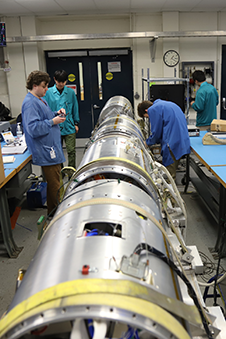 CIBER-2 integration at Wallops.
CIBER-2 integration at Wallops.36.383 UG ZEMCOV/RIT
April 16, 2023
Cosmic Infrared Background ExpeRiment (CIBER) 2
36.383 UG Terrier-Black Brant sounding rocket was launched from White Sands Missile Range, NM, on April 16, 2023. No science was collected due to termination of flight shortly after launch. CIBER-2 (Cosmic Infrared Background ExpeRiment) is a near-infrared rocket-borne instrument designed to conduct comprehensive multi-band measurements of extragalactic background light (EBL) anisotropy on arcsecond to degree angular scales.
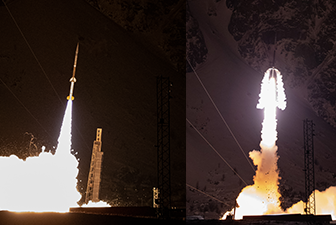 The first two VortEx rockets launching from Andoya Space, Norway.
Credit:NASA photo/Danielle Johnson.
The first two VortEx rockets launching from Andoya Space, Norway.
Credit:NASA photo/Danielle Johnson.41.127 & 36.361 UE Lehmacher/Clemson University
March 23, 2023
Vorticity Experiment (VortEx)
41.127 UE Terrier-Improved Orion and 36.361 UE Black Brant IX sounding rockets were launched from Andoya Space, Norway, on March 23, 2023.The science objective of the Vorticity Experiment (VortEx) is to better understand nonlinear gravitywave interactions in the upper mesosphere and lower thermosphere, the formation of vortices, and the importance of mesoscale stratified turbulence.
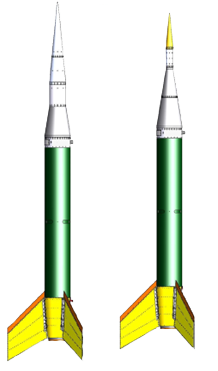 Drawing of the two MesOrion rockets.
Drawing of the two MesOrion rockets.12.089 & 12.090 WT Edwards/NASA Wallops Flight Facility
February 16, 2023
MesOrion
12.089 & 12.090 WT single stage Orion sounding rockets were launched from Wallops Island, VA on February 16, 2023.The purpose of these launches were to test a new capability to support science reseach in the mesosphere.
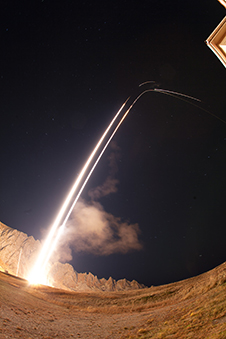 Composite image of two Terrier-Black Brants launching from Andoya, Norway. Credit: NASA photo Lee Wingfield.
Composite image of two Terrier-Black Brants launching from Andoya, Norway. Credit: NASA photo Lee Wingfield.36.359 & 36.364 UE Bounds/University of Iowa
November 20, 2022
Aurora Current and Electrodynamics Structure (ACES) 2
36.359 & 36.364 UE Terrier-Black Brant sounding rockets were launched from Andoya Space in Norway on November 20, 2022.The purpose of the ACES-2 experiment was to determine the distribution of the ionospheric currents and the associated energy dissipation in a stable arc, and determine the role of the Alfven resonator in governing the structuring of current closure. Two Black Brant IX sounding rockets were launched for these experiments.
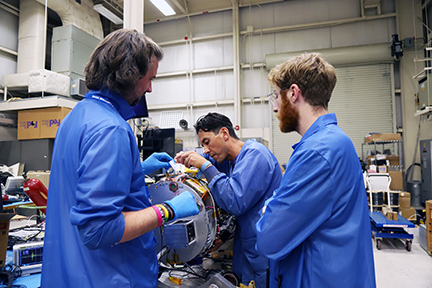 Science team working on tREXS during integration at Wallops.
Science team working on tREXS during integration at Wallops.36.367 UH McEntaffer/Penn State Univ
September 25, 2022
the Rockets for Extended-Source X-ray Spectroscopy (tREXS)
36.367 UH Terrier-Black Brant sounding rocket was launched from White Sands Missile Range, NM, on September 25, 2022.The purpose of the tREXS mission was to study the soft x-ray emissions from the Cygnus Loop Supernova Remnant. Supernovae are a key source of energy in the interstellar medium.
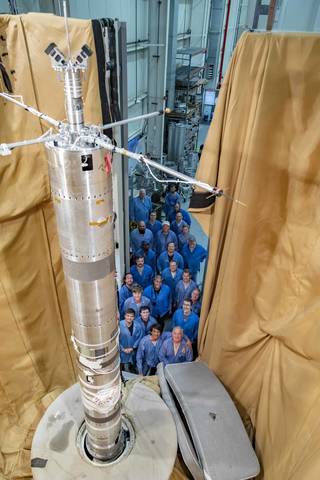 SpEED Demon team with payload.
SpEED Demon team with payload.46.025 UE BARJATYA/EMBRY RIDDLE UNIVERSITY
August 23, 2022
Sporadic E ElectroDynamics Demonstration (SpEED Demon)
46.025 UE Terrier-Improved Malemute sounding rocket was launched from Wallops Island, VA on August 23, 2022. Sporadic E ElectroDynamics Demonstration (SpEED Demon), is a technology demonstration mission for the SEED campaign. SpEED Demon’s goal is to reduce risk surrounding new experiment instrumentation and possibly capture comparative mid-latitude science with in-situ measurements of Es layers with thesame instruments planned to fly on SEED.
36.355 UH FIGUEROA/NORTHWESTERN UNIVERSITY
August 21, 2022
Micro-X
36.355 UH Terrier-Black Brant sounding rocket was launched from White Sands Missile Range, NM on August 21, 2022. Micro-X uses a type of X-Ray sensor called a Transition-Edge Sensor (TES). The sensor array will be cooled by an AdiabaticDemagnetizing Refrigerator (ADR). The goal of Micro-X was to obtain microcalorimeterspectra from an astronomical source.
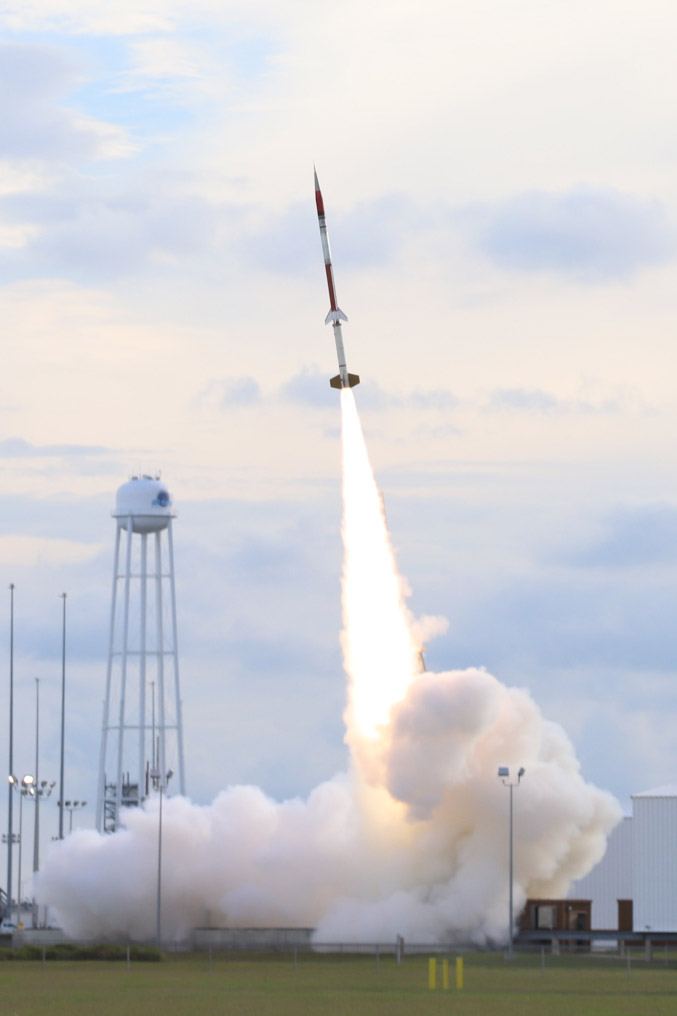 RockSat-X launches from Wallops Island, VA.
RockSat-X launches from Wallops Island, VA.46.036 UO KOEHLER/COLORADO SPACE GRANT
August 11, 2022
RockSat-X
46.036 UO Terrier-Improved Malemute sounding rocket was launched from Wallops Island, VA on August 11, 2022. RockSat-X student experiments are developed with an objective of providing students with an enhanced experience of flying experiments that are exposed to the space environment. The students gain experience in designing, building, testing, and then flying their experiments on a sub-orbital space flight. It also exposes students to the design and mission lifecycle. The payload was recovered and the experiments returned to the students.
36.350 UG FLEMING/UNIV OF COLORADO
July 11, 2022
Dual-channel Extreme Ultraviolet Continuum Spectrograph (DEUCE)
36.350 UG Terrier-Black Brant sounding rocket was launched from Arnhem Space Center, Australia on July 11, 2022. The
Purpose of the DEUCE experiment was to generate the first EUV spectrum of the most accessible potential exoplanetary system, the Alpha (α) Centauri A+B System. The spectrum range for DEUCE was in the 500 – 900 Å range. At present, no low-mass star other than the Sun has ever been observed in the 500 – 900 Å spectral window. These observations will provide a crucial, and unique, input for models of planets orbiting G-type and K-type stars.
36.339 UG FRANCE/UNIV OF COLORADO
July 6, 2022
Suborbital Imaging Spectrograph for Transition region Irradiance from Nearby Exoplanet host stars (SISTINE)
36.339 UG Terrier-Black Brant sounding rocket was launched from Arnhem Space Center, Australia on July 6, 2022. The objective of the SISTINE mission was to spectroscopically observe the science target— α Cen A+B, a binary star system composed of G and K stars. By examining this relatively nearby solar system analog with a claimed exoplanet candidate, SISTINE aimed to characterize the FUV spectral energy distribution of these low mass systems.
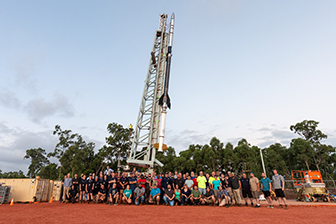 XQC payload team in Australia. Credit: NASA photo Brian Bonsteel
XQC payload team in Australia. Credit: NASA photo Brian Bonsteel36.347 UH McCAMMON/UNIV OF WISCONSIN
June 26, 2022
X-ray Quantum Calorimeter Experiment (XQC)
36.347 UH Terrier-Black Brant sounding rocket was launched from Arnhem Space Center, Australia on June 26, 2022.The purpose of the XQC mission was to collect high resolution spectroscopy of thediffuse X-ray background in the .1 to 3 keV range.
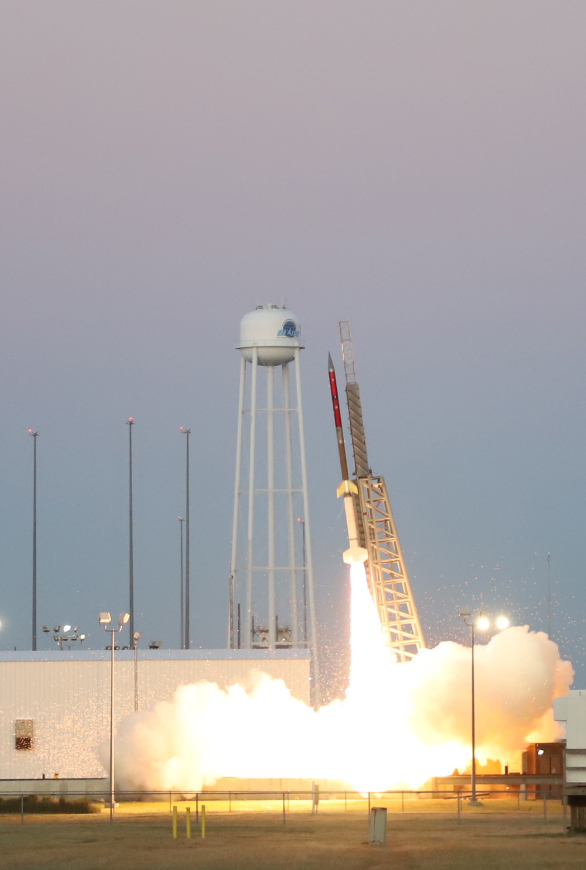 RockOn launches from Wallops Island, VA.
RockOn launches from Wallops Island, VA.41.131 UO KOEHLER/COLORADO SPACE GRANT
June 24, 2022
RockOn
41.131 UO Terrier-Improved Orion sounding rocket was launched from Wallops Island, VA on June 24, 2022.This was the fourteenth flight of the hands-on, university-level rocketflight-training workshop known as “RockOn.” RockOn is a collaborative effort between the Colorado Space GrantConsortium (COSGC), the Virginia Space Grant Consortium, and Wallops Flight Facility.
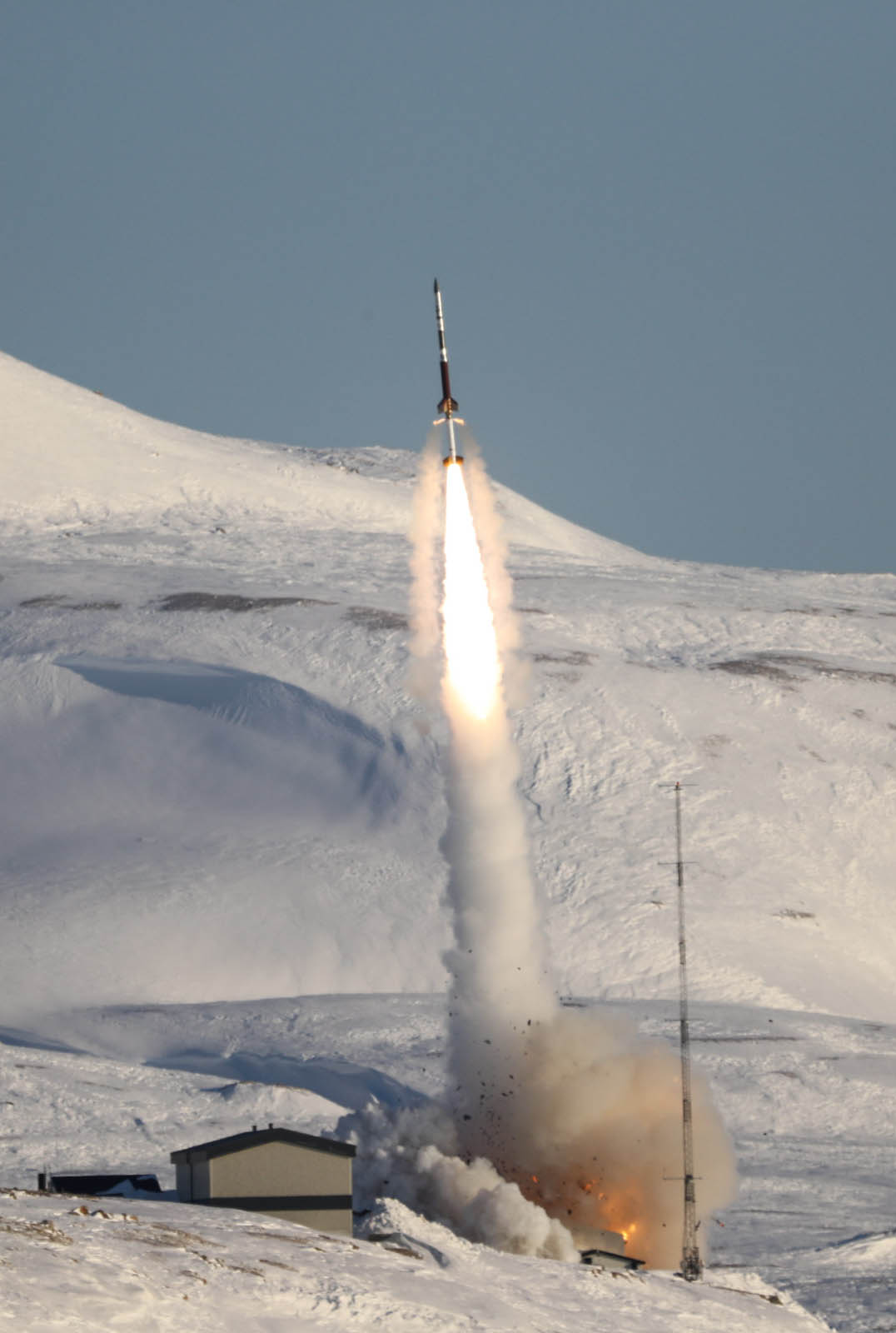 Endurance launches from Svalbard, Norway. Credit: NASA photo Brian Bonsteel
Endurance launches from Svalbard, Norway. Credit: NASA photo Brian Bonsteel47.001 GE ENDURANCE
May 11, 2022
PI: Dr. Collinson/NASA GSFC
47.001 GE Terrier-Oriole-Nihka sounding rocket was launched from Svalbard, Norway on May 11, 2022.The purpose of the Endurance mission was to make the first measurement of the magnitude and structure of the electric field generated by Earth’s Ionosphere. The primary instrument is the Photoelectron Spectrometer (PES) consisting of eight Dual Electrostatic Analyzers (DESA).
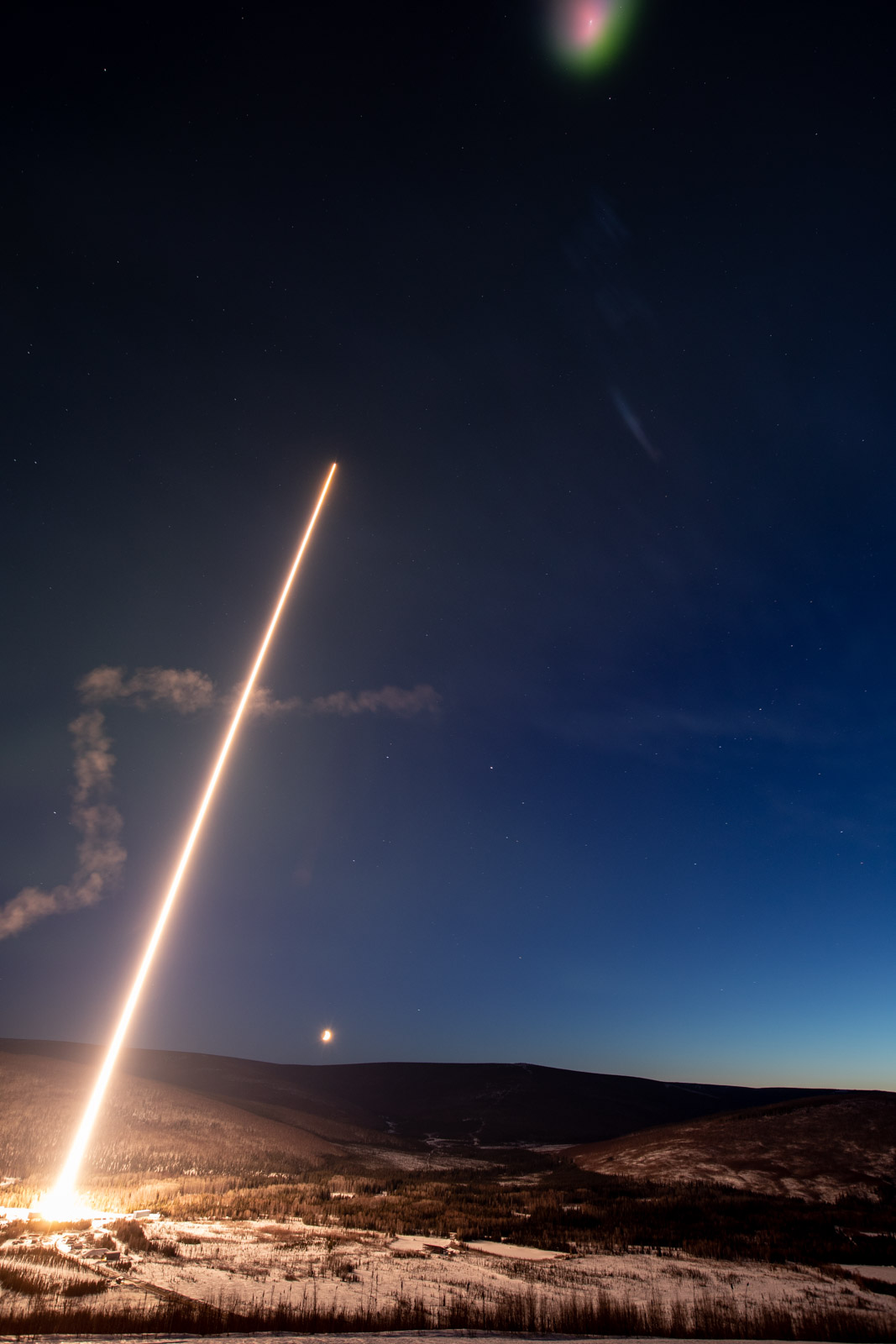 INCAA launch from Poker Flat Research Range, AK.. Credit: NASA photo Terry Zaperach
INCAA launch from Poker Flat Research Range, AK.. Credit: NASA photo Terry Zaperach36.360 & 46.031 UE KAEPPLER/CLEMSON UNIVERSITY
April 7, 2022
Ion-Neutral during Active Aurora (INCAA)
36.360 UE Terrier-Black Brant and 46.031 UE Terrier-Improved Malemute sounding rockets were launched from Poker Flat Research Range, AK on April 7. 2022.The science objective for the INCAA sounding rocket mission is to understand the interactions between the plasma and the neutral atmosphere during active aurora, and how this interaction affects energy deposition in the E-region ionosphere. Two rockets were launched to measure these variables.
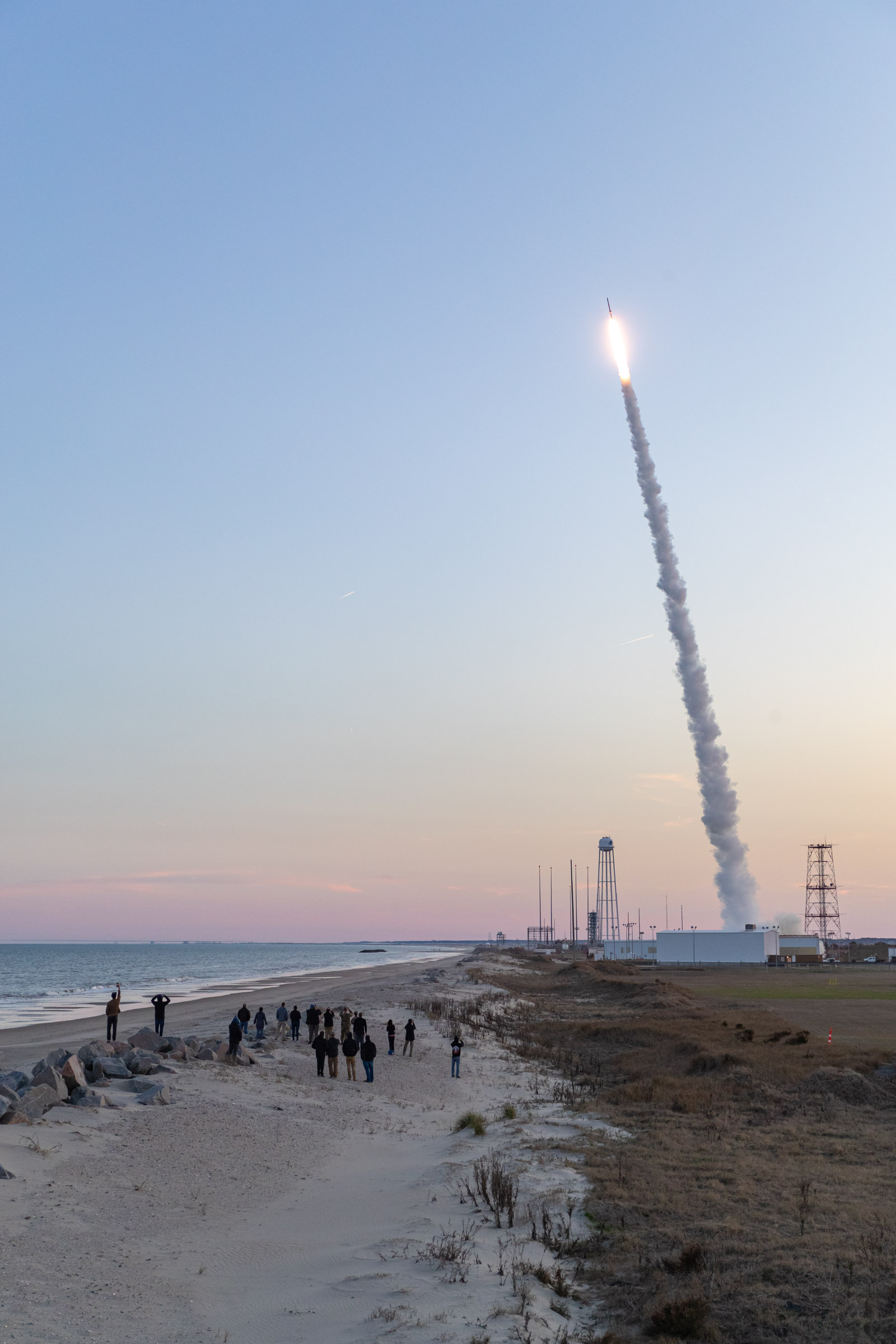 BOLT-2 launch from Wallops Island, VA. Credit: NASA photo Allison Stancil
BOLT-2 launch from Wallops Island, VA. Credit: NASA photo Allison Stancil46.027 DR HOLDEN/AFRL
March 21, 2022
BOundary Layer Turbulence 2 (BOLT-2)
46.027 DR Terrier-Improved Malemute sounding rocket was launched from Wallops Island, VA on March 21, 2022. BOLT-2 investigated boundary layer transition, turbulent heating, and drag at hypersonic conditions. Boundary layer transition to turbulence is the process where smooth, laminar flow becomes unstable after which turbulence dominates and significantly increases heating and drag on high-speed vehicles.
36.307 DS TUN/NAVAL RESEARCH LABORATORY
March 9, 2022
HElium Resonance Scatter in the Corona and HELiosphere (HERSCHEL)2
36.307 DS Black Brant IX was launched from White Sands Missile Range, NM on March 9, 2022.The HERSCHEL program investigated the origin of the slow solar wind, variation of helium abundance in coronal structures and facilitated future investigation of Coronal Mass Ejections (CMEs), kinematics, and solar cycle evolution of the electron, proton, and helium corona.
.
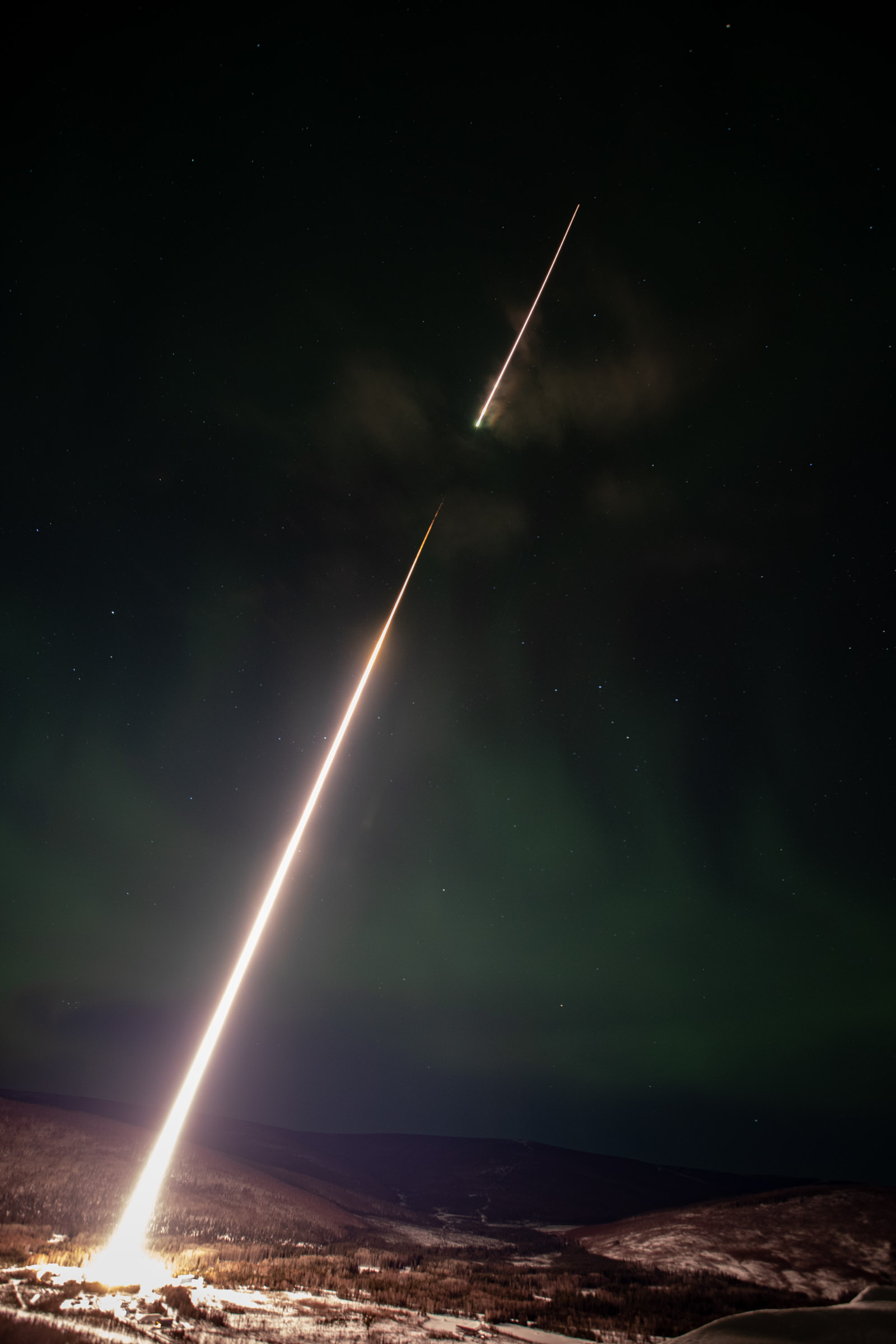 LAMP launches from Poker Flat Research Range, Alaska. Credit: NASA photo Terry Zaperach
LAMP launches from Poker Flat Research Range, Alaska. Credit: NASA photo Terry Zaperach36.351 GE HALFORD/NASA GSFC
March 6, 2022
Loss through Auroral Microburst Pulsations (LAMP)
36.351 GE Terrier-Black Brant sounding rocket was launched from Poker Flat Research Range, AK on March 6, 2022. The overall objective of the Loss thru Auroral Microburst Precipitation (LAMP) mission was to measure pulsating aurora, the highest energy aurora, to see if it plays a role in emptying the radiation belts.
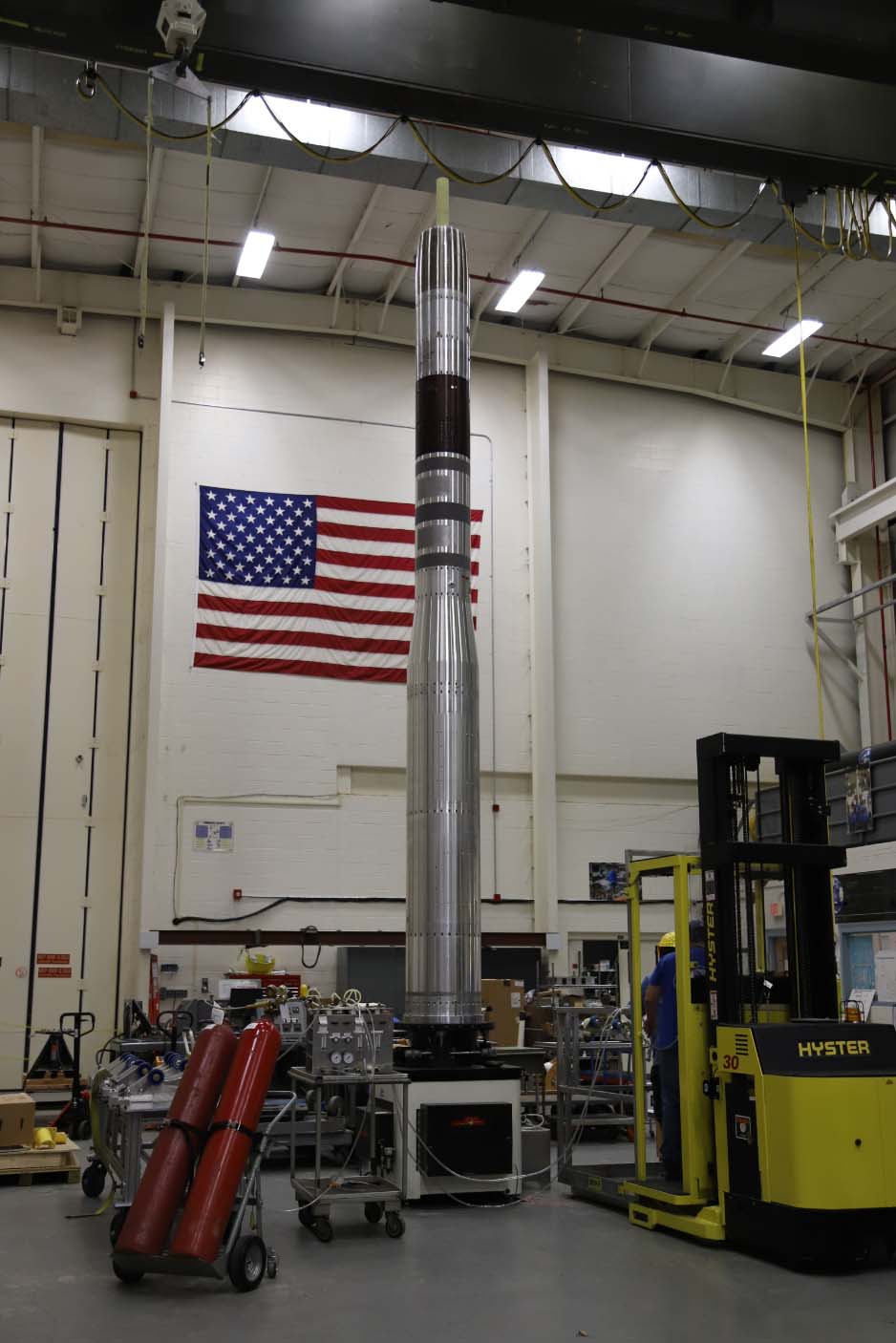 DXL payload during testing at NASA Wallops.
DXL payload during testing at NASA Wallops.36.363 UH Galeazzi/University of Miami
January 9, 2022
Diffuse X-Rays from the Local Galaxy (DXL) 4
36.363 UH Terrier-Black Brant sounding rocket was launched from Wallops Island, VA on January 9, 2022. The Diffused X-ray emission from the Local galaxy (DXL) is a series of sounding rocket missions to study the Solar Wind Charge Exchange (SWCX) and Local Hot Bubble (LHB) X-ray emissions which are believed to be major contributors to the Diffused X-ray Background (DXB). This was the fourth launch in the series.
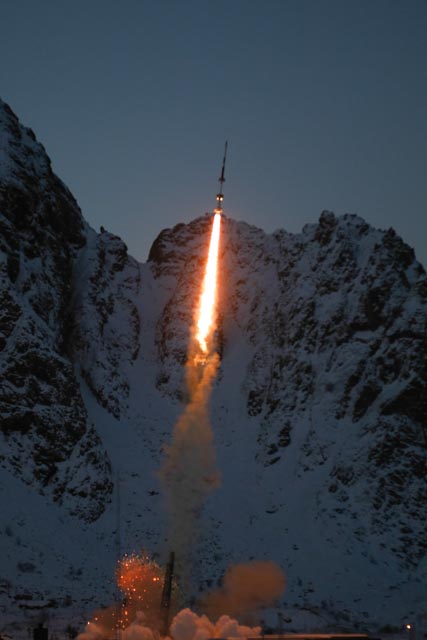 CREX-2 Launch from Andoya Space, Norway. Credit: NASA Photo Lee Wingfield.
CREX-2 Launch from Andoya Space, Norway. Credit: NASA Photo Lee Wingfield.49.004 UE Conde/University of Alaska
December 1, 2021
Cusp Region EXperiment (C-REX) 2
49.004 UE Oriole IV sounding rocket was launched from Andoya Space, Norway on December 1, 2021. The purpose of the Cusp Region Experiment (C-REX) 2 experiment was to identify mechanisms responsible for sustaining a region of neutral mass density at 400km altitude that appears to be a permanent feature of the Earth’s cusp-region thermosphere.
36.373 UG FRANCE/UNIVERSITY OF COLORADO
November 8, 2021
Suborbital Imaging Spectrograph for Transition region Irradiance from Nearby Exoplanet host stars (SISTINE)
36.373 UG Black Brant IX was launched from White Sands Missile Range, NM on November 8, 2021.SISTINE is designed to enable studies of the ultraviolet radiation environment around low-mass stars and the effects of that UV on potential exoplanet atmospheres.The target for SISTINE-2 is the Procyon A+B binary star system composed
of a late main sequence F-type star and a cool white dwarf companion. The primary target is Procyon A, with Procyon B as a secondary target. Procyon A is a good candidate for
characterization of a low-to-intermediate mass star for which
there are no models that accurately predict the FUV spectral
energy distribution (SED).
.
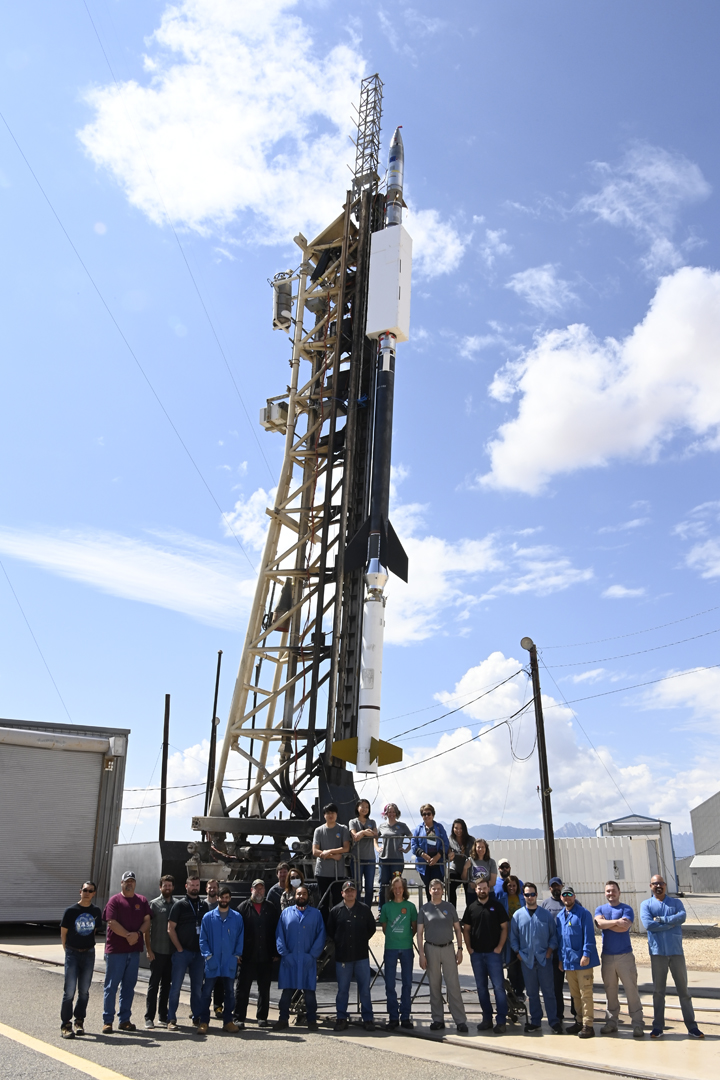 CLASP 2.1 team photo. Credit:Mike Smith, WSMR Visual Information Branch.
CLASP 2.1 team photo. Credit:Mike Smith, WSMR Visual Information Branch.36.374 NS McKenzie/NASA MSFC
October 8, 2021
Chromospheric Lyman-Alpha Spectro Polarimeter 2.1 (CLASP)
36.374 NS Terrier-Black Brant sounding rocket was launched from White Sands Missile Range on October 8, 2021. The science goal of the CLASP2.1 mission was the mapping of circular polarization of the Mg II
h&k
lines over a solar active region caused by scattering and magnetic effects.
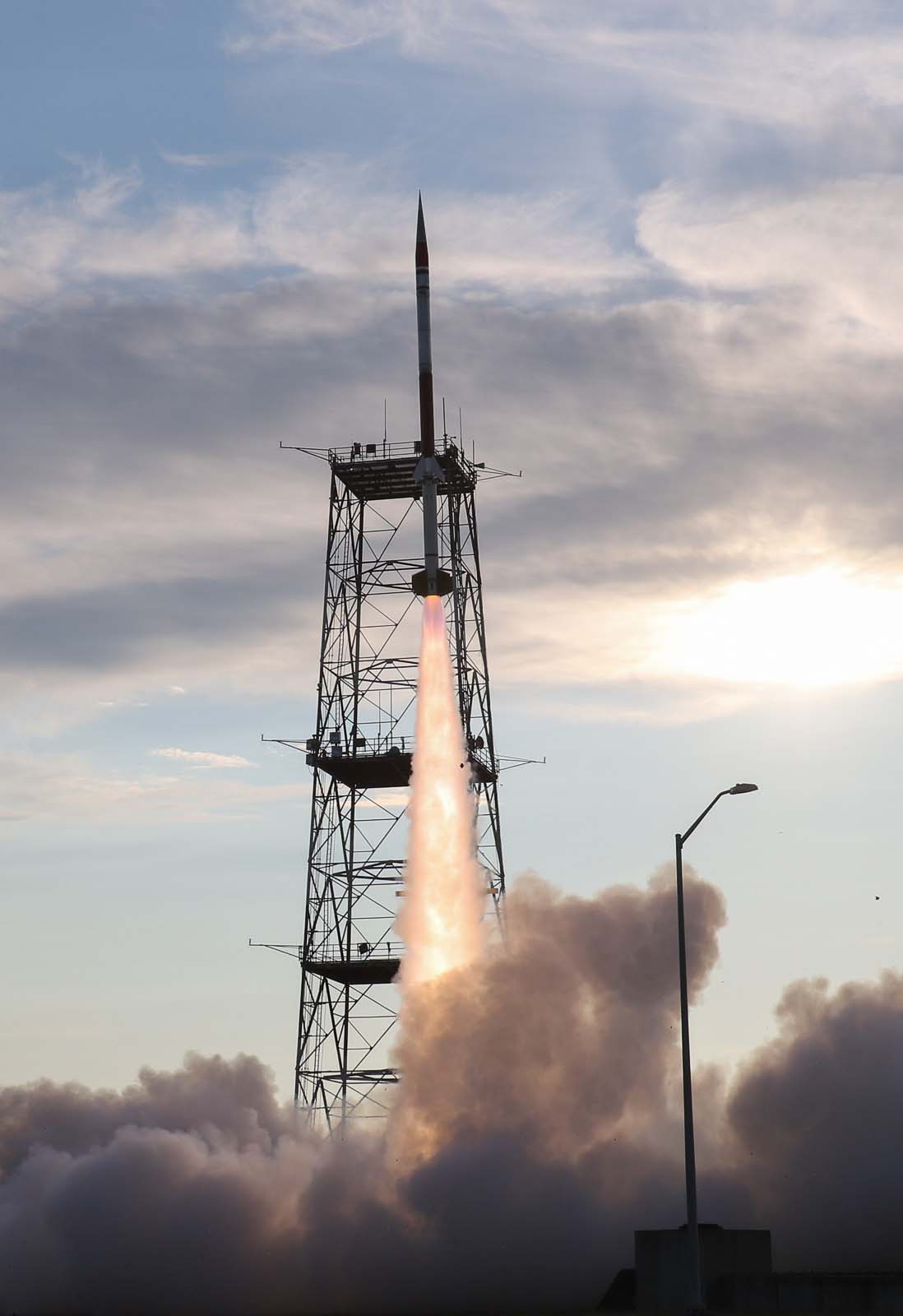 HOTShot launches from Wallops Island, VA. Credit: Jamie Adkins/NASA.
HOTShot launches from Wallops Island, VA. Credit: Jamie Adkins/NASA.46.033 AR Leathe/Sandia
September 11, 2021
HOTShot
46.033 AR Terrier-Improve Malemute sounding rocket was launched from Wallops Island, VA on September 11, 2021. The flight is part of the HOTShot program, short for High Operational Tempo, which collects scientific data that benefits aerospace research and informs future weapon designs for the U.S. nuclear enterprise. Its non-nuclear scientific experiments evaluate prototypes and help develop high-fidelity computer models and mechanical flight simulators
36.353 US Woods/University of Colorado -
September 9, 2021
SDO EVE Underflight Calibration Experiment
36.353 US Black Brant IX was launched from White Sands Missile Range, NM on September 9, 2021. The primary objective for this mission was to provide an underflight calibration for the EUV Variability Experiment (EVE) aboard the NASA Solar Dynamics Observatory (SDO) satellite. The EVE program provides solar EUV irradiance data for NASA’s Living With the Star (LWS) program, including near real-time data products for use in operational atmospheric models that specify the space environment and to assist in forecasting space weather operations.
.
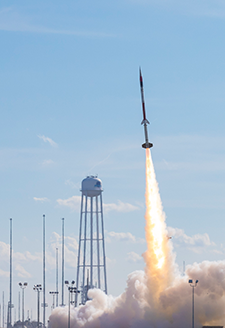 RockSat-X launches from Wallops Island, VA.
RockSat-X launches from Wallops Island, VA.46.030 UO Koehler/Colorado Space Grant Consortium
August 19, 2021
RockSat-X
46.030 UO Terrier-Improve Malemute sounding rocket was launched from Wallops Island, VA on August 19, 2021. RockSat-X student experiments are developed with an objective of providing students with an enhanced experience of flying experiments that are exposed to the space environment. The students gain experience in designing, building, testing, and then flying their experiments on a sub-orbital space flight. It also exposes students to the design and mission lifecycle. The payload was recovered and the experiments returned to the students.
36.319 NS Winebarger/NASA Marshall Space Flight Center -
July 30, 2021
Marshall Grazing Incidence X-ray Spectrometer (MaGIXS)
36.319 NS Black Brant IX was launched from White Sands Missile Range, NM on July 30, 2021. The science goal of MaGIXS was to determine the frequency of heating in active region cores on the Sun by making four critical observations.
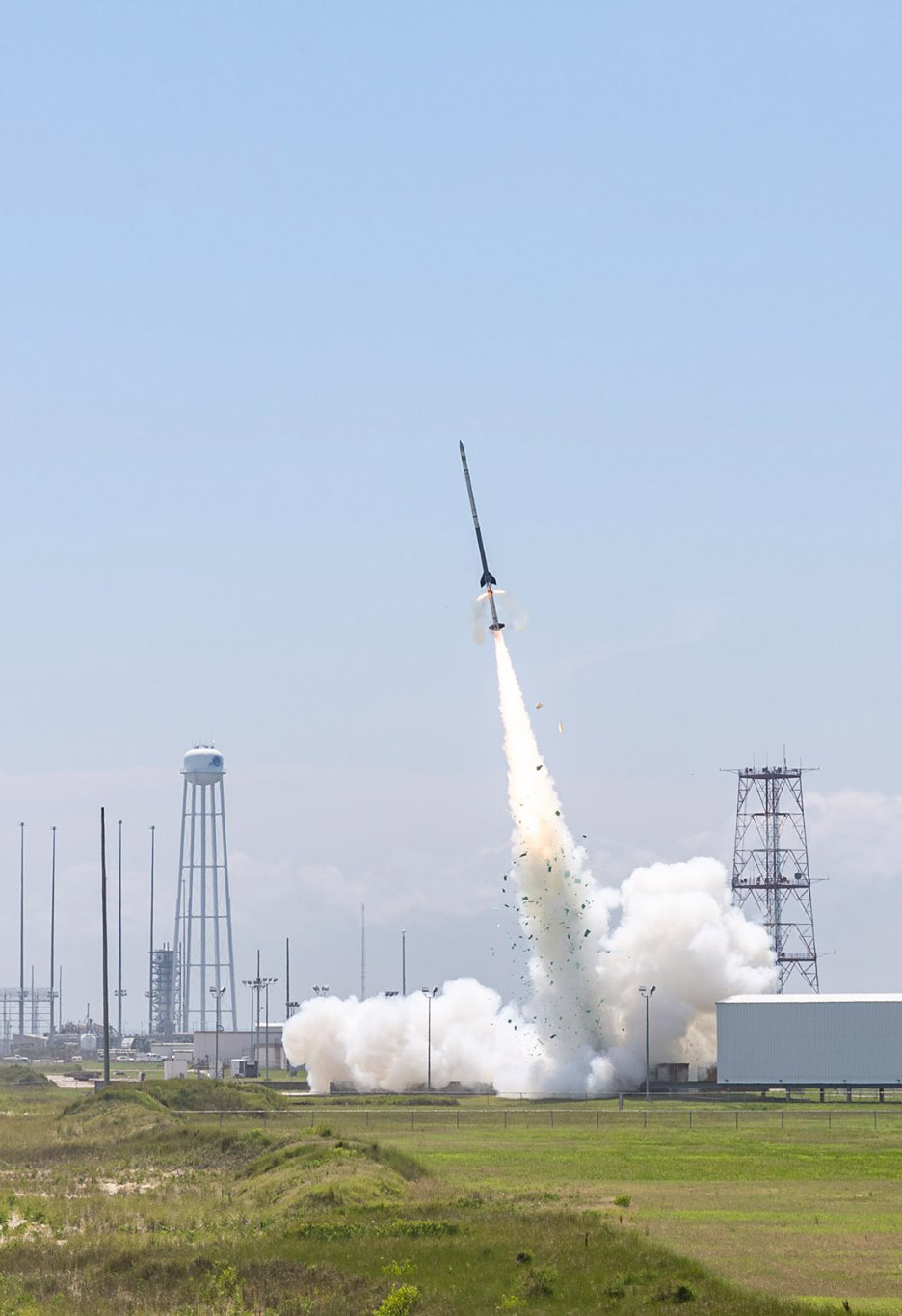 Second Dynamo launch from Wallops Island, VA. NASA Photo/Allison Stancil
Second Dynamo launch from Wallops Island, VA. NASA Photo/Allison Stancil36.357 GE PFAFF/NASA GSFC
July 11, 2021
Dynamo-2
36.357 GE Black Brant IX was launched from Wallops Island, VA on July 11, 2021. The Dynamos, Winds, and Electric Fields in the Daytime Lower Ionosphere missions (Dynamo-2) are newly designed identical payloads. Each payload includes a GSFC main payload with a deploying Maynard sphere and a UNH sub-payload. The objective of the Dynamo-2 missions is to measure DC electric fields, plasma density, currents, neutral winds, neutral density and temperature, and ion mass distributions. The missions are supported with NASA’s ICON satellite measurements, and Wallops ground based measurements from the GSFC magnetometer, the Vertical Incidence Pulsed Ionospheric Radar (VIPIR), and the digital ionosonde. The 36.357 payload was launched into disturbed conditions.
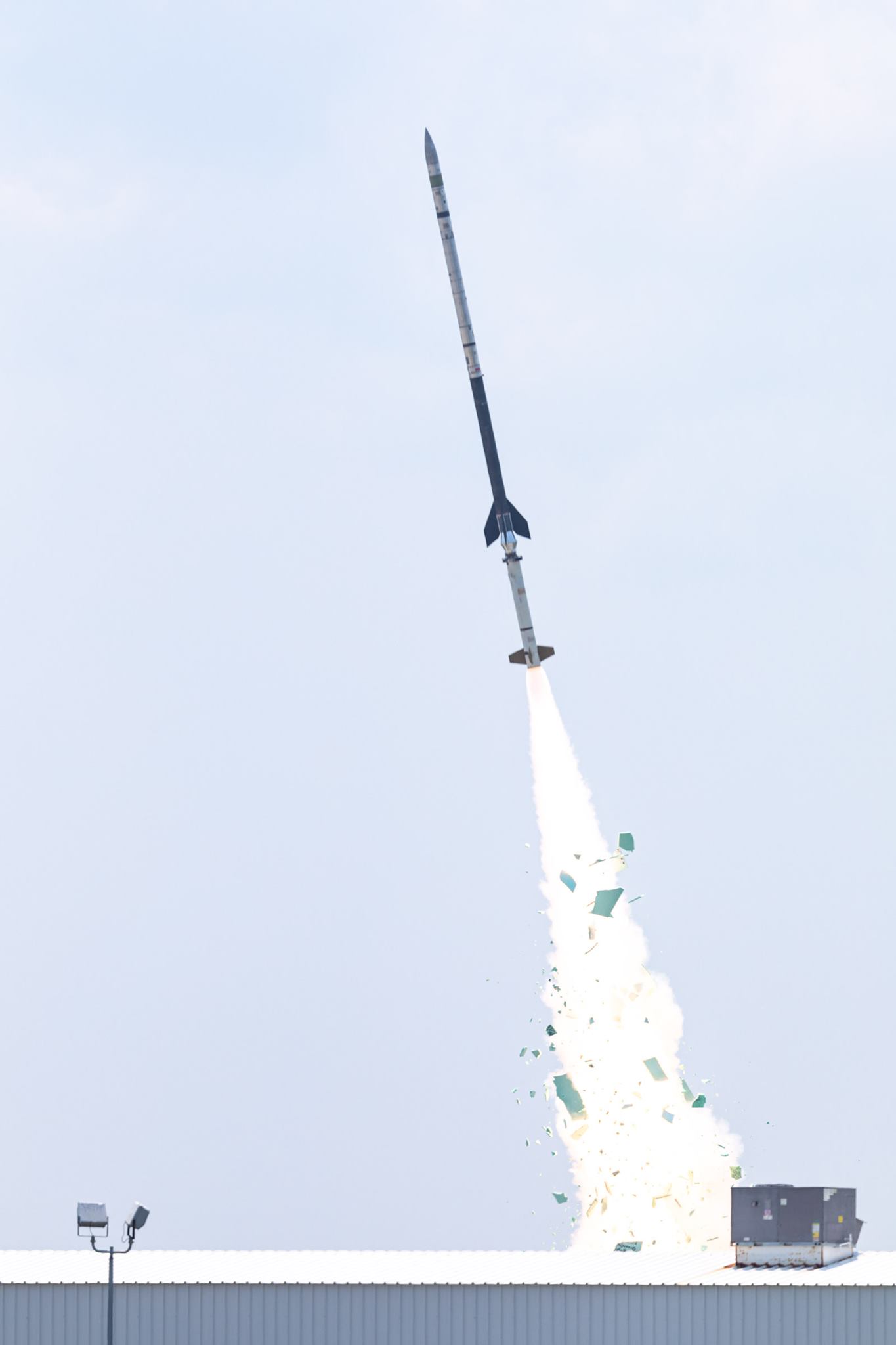 First Dynamo launch from Wallops Island, VA. NASA Photo/Allison Stancil
First Dynamo launch from Wallops Island, VA. NASA Photo/Allison Stancil36.358 GE PFAFF/NASA GSFC
July 7, 2021
Dynamo-2
36.358 GE Black Brant IX was launched from Wallops Island, VA on July 7, 2021. The Dynamos, Winds, and Electric Fields in the Daytime Lower Ionosphere missions (Dynamo-2) are newly designed identical payloads. Each payload includes a GSFC main payload with a deploying Maynard sphere and a UNH sub-payload. The objective of the Dynamo-2 missions is to measure DC electric fields, plasma density, currents, neutral winds, neutral density and temperature, and ion mass distributions. The missions are supported with NASA’s ICON satellite measurements, and Wallops ground based measurements from the GSFC magnetometer, the Vertical Incidence Pulsed Ionospheric Radar (VIPIR), and the digital ionosonde. The 36.358 payload launched into quiet conditions. The 36.357 payload will be launch into disturbed conditions.
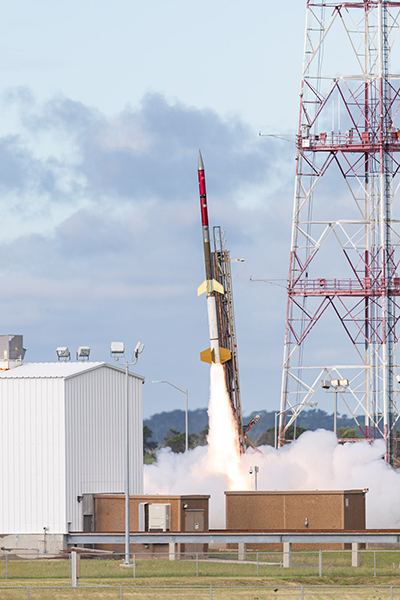 RockOn launching from Wallops Island, VA. NASA Photo/Allison Stancil
RockOn launching from Wallops Island, VA. NASA Photo/Allison Stancil41.130 UO KOEHLER/COLORADON SPACE GRANT
June 25, 2021
RockOn
41.130 UO Terrier-Improved Orion was launched from Wallops Island, VA on June 25, 2021. This mission was the thirteenth flight of the hands-on, university-level rocket flighttraining workshop known as “RockOn.” RockOn is a collaborative effort between the Colorado Space Grant Consortium (COSGC), the Virginia Space Grant Consortium, and Wallops Flight Facility
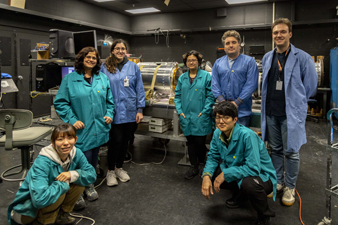 CIBER 2 Science Team at Wallops in January 2020.
CIBER 2 Science Team at Wallops in January 2020.36.281 UG ZEMCOV/RIT
June 7, 2021
Cosmic Infrared Background ExpeRiment (CIBER) 2
36.381 UG Black Brant IX was launched from White Sands Missile Range, NM on June 7, 2021.CIBER 2 investigated the spectral and
spatial properties of the extragalactic near-infrared background, and required acquisition of multiple targets with minimal contamination from terrestrial sources of infrared emission.
 VIPER Launch. Credit:Terry Zaperachl/NASA Wallops
VIPER Launch. Credit:Terry Zaperachl/NASA Wallops46.028 UE BONNELL/UNIVERSITHY OF BERKELEY -
May 26, 2021
Vlf trans-Ionospheric Propagation Experiment Rocket (VIPER)
46.028 UE Terrier-Improved Malemute was launched from Wallops Island, VA on May 26, 2021.The VIPER mission is an observational and modeling effort to understand Very Long Frequency (VLF) wave penetration through and propagation above the Earth’s ionosphere.
36.322 GS Daw/NASA Goddard Space Flight Center -
May 18, 2021
Extreme Ultraviolet Normal-Incidence Spectrograph (EUNIS)
36.322 GS Black Brant IX was launched from White Sands Missile Range, NM on May 18, 2021. The EUNIS mission observed high temperature lines to detect super-heated (~10MK) plasma thought to drive energization and eruptive events of solar atmosphere & space weather. A new channel provided first imaging spectroscopy of the Sun in 92-113 Å soft X-ray wavelength region.
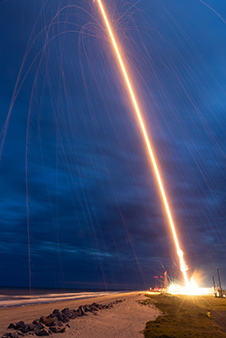 KiNET-X Launch. Credit:Allison Stancil/NASA Wallops
KiNET-X Launch. Credit:Allison Stancil/NASA Wallops52.007 UE DELAMERE/UNIVERSITHY OF ALASKA -
May 16, 2021
Kinetic-scale Energy and momentum Transport eXperiment (KiNET-X)
52.007 UE Black Brant XII-A was launched from Wallops Island, VA on May 16, 2021.The KiNET-X mission studied how momentum transport is affected by kinetic-scale physics, i.e. formation of parallel electric fields and dissipation, how electromagnetic energy is converted into plasma kinetic and thermal energy, and what the interplay is between fluid- and kinetic-scale processes
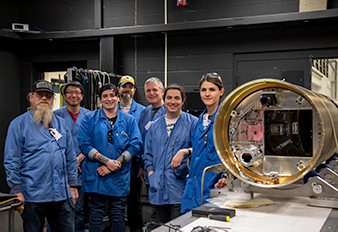 SHIELDS Science Team at Wallops in February 2020.
SHIELDS Science Team at Wallops in February 2020.36.324 US Harris/University of Arizona -
April 19, 2021
Spatial Heterodyne Interferometric Emission Line Dynamics Spectrometer (SHIELDS)
36.324 US Black Brant IX was launched from White Sands Missile Range, NM on April 19, 2021. The objective of the SHIELDS mission was to obtain a spatial map of scattered solar ultraviolet (UV) emission from interplanetary hydrogen (IPH) that has crossed, and been modified by, the ion pile-up along the outer edge of the heliosphere.
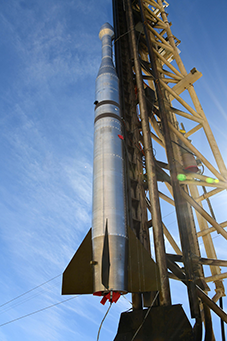 12.088 ABFT on the launcher. Credit:Visual Information Branch/WSMR
12.088 ABFT on the launcher. Credit:Visual Information Branch/WSMR12.088 NR Gilbert/NASA Langley Research Center
March 30, 2021
Aerodynamic Buffet Flight Test (ABFT)
12.088 NR was launched from White Sands Missile Range, NM on March 30, 2021. Dynamic loads resulting from transonic aerodynamic buffet are often the largest contributor to launch vehicle structural load margins, and proper understanding of that phenomenon is an important aspect of launch vehicle design. Over predicting those loads will lead to an inefficient, heavier than necessary structural design, while under predicting them could lead to structural failure. This mission is designed to gather flight data on a vehicle shape that has only been tested in wind tunnels previously.
36.368 UG Green/University of Colorado
November 2, 2020
Dual-channel Extreme Ultraviolet Continuum Experiment (DEUCE)
36.368 UG Black Brant IX was launched from White Sands Missile Range, NM on November 2, 2020. The Dual-channel Extreme Ultraviolet Continuum Experiment (DEUCE) is a spectrograph operating from 650 – 1100Å. DEUCE measured how much ionizing photons B stars, such as the target star for this mission ß canis major, produce.
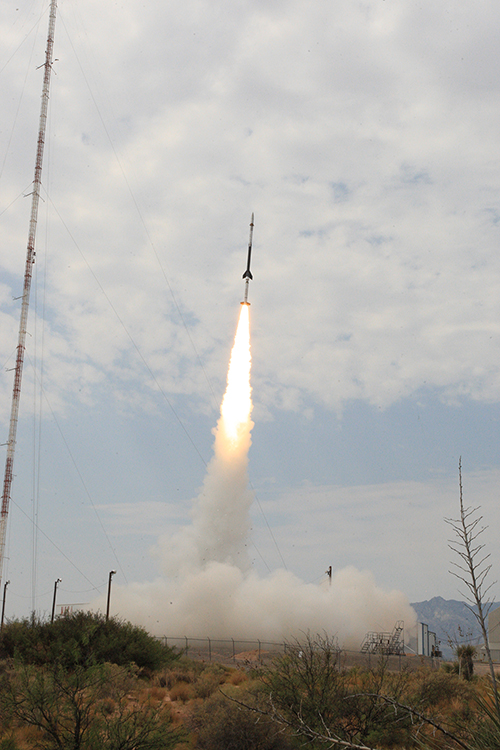 DUST-2 Launch from WSMR.. Credit:Visual Information Branch/WSMR
DUST-2 Launch from WSMR.. Credit:Visual Information Branch/WSMR36.365 GB Nuth/NASA Goddard Space Flight Center September 8, 2020
Determining Unknown yet Significant Traits (DUST)2
36.365 GB Black Brant IX was launched from White Sands Missile Range, NM
on September 8, 2020. The purpose of the DUST-2 experiment was to measure important variables in the end-to-end process of grain formation in circumstellar outflows around AGB stars and model the physical and chemical properties of the dust.
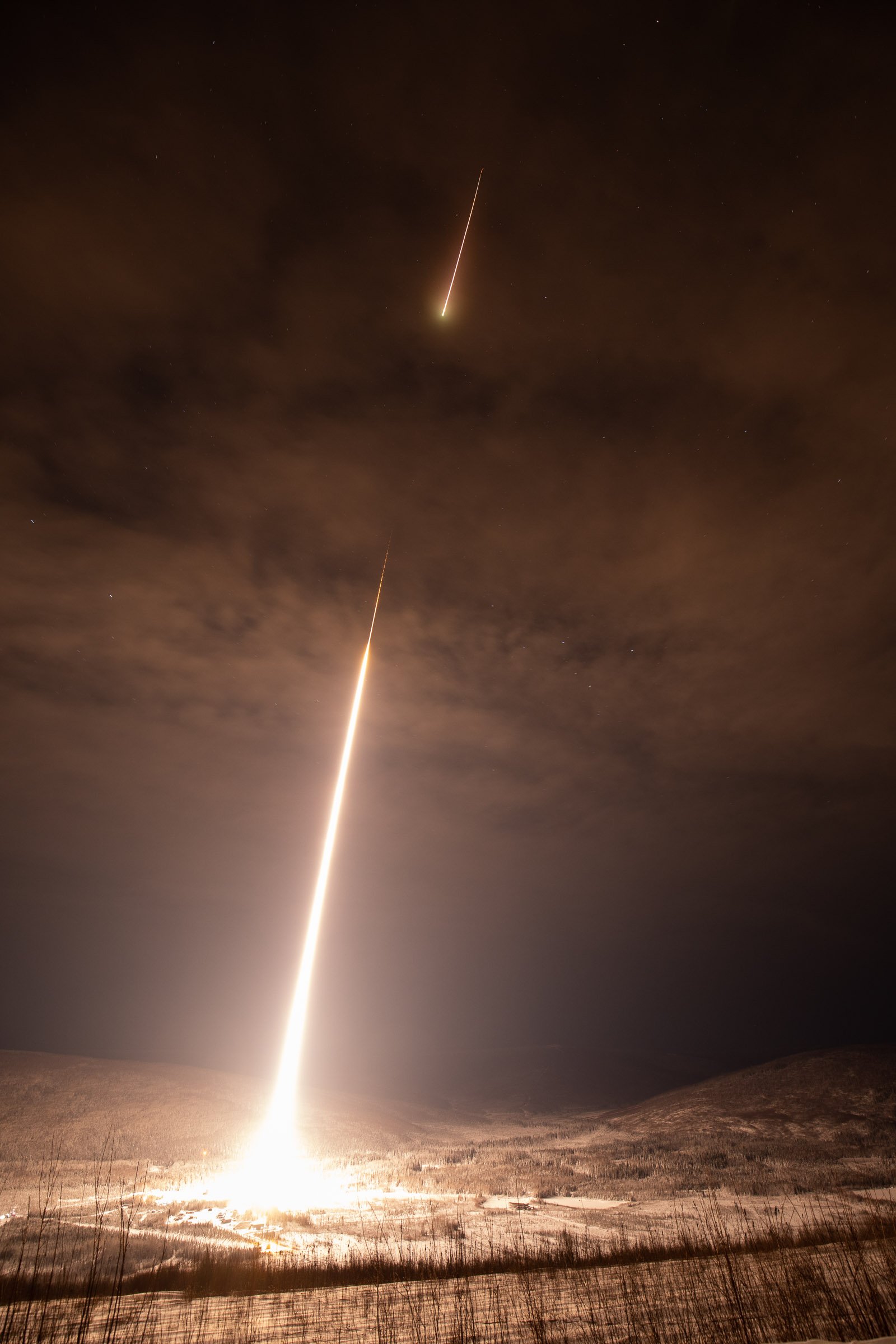 PolarNOx launch from Poker Flat Research Range, Alaska.. Credit:Chris Perry/NASA.
PolarNOx launch from Poker Flat Research Range, Alaska.. Credit:Chris Perry/NASA.36.356 UE Bailey/Virginia Tech January 27, 2020
Polar Night Nitric Oxide (Polar NOx)
36.356 UE Black Brant IX was launched from Poker Flat Research Range, AK
on January 27, 2020. The purpose of the Polar Night Nitric Oxide “Polar NOx” experiment was to measure the concentration of nitric oxide in the mesosphere and lower thermosphere in the nighttime polar region.
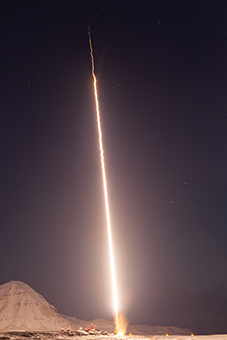 CHI launch from Svalbard, Norway. Credit:Allison Stancil-Ervin/NASA.
CHI launch from Svalbard, Norway. Credit:Allison Stancil-Ervin/NASA.36.349 UE Larsen/Clemson University December 10, 2019
Cusp Heating Investigation (CHI)
36.349 UE Black Brant IX was launched from Svalbard, Norway on December 10, 2019. The purpose of the mission was to measure neutral upwelling and high-resolution electric fields over an extended region in the Cusp. The CHI mission is part of the Grand Challenge Initiative - Cusp, an international scientific data sharing partnership.
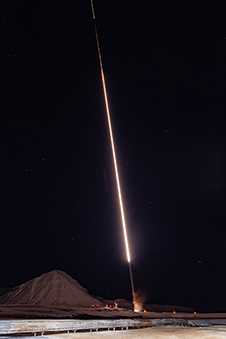 ICI-5 launch from Svalbard, Norway. Credit:Allison Stancil-Ervin/NASA.
ICI-5 launch from Svalbard, Norway. Credit:Allison Stancil-Ervin/NASA.46.029 IE Moen/University of Oslo November 26, 2019
Investigation of Cusp Irregularities (ICI) 5
46.029 IE Terrier-Improved Malemute was launched from Svalbard, Norway on November 26, 2019. The Investigation of Cusp Irregularities (ICI) 5 mission is part of the Grand Challenge Initiative - Cusp, an international scientific data sharing partnership.
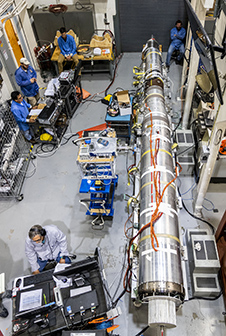 FORTIS payload sequence testing at Wallops.
FORTIS payload sequence testing at Wallops.36.352 UG McCandliss/Johns Hopkins October 27, 2019
Far-Ultraviolet Off Rowland-circle Telescope for Imaging and Spectroscopy
36.352 UG Terrier-Black Brant was launched from White Sands Missile Range, NM on October 27, 2019. FORTIS is a multi-object spectro/telescope equipped with a next-generation microshutter array (NGMSA) capable of imaging individual stars within NGMSA slitlets while simultaneously obtaining their far-UV spectra. The primary science goal for this mission was to study massive hot star clusters in the star-forming Galaxy M33.
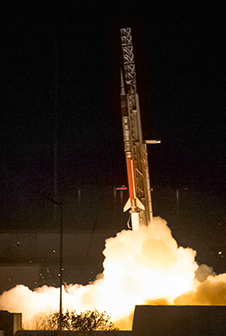 SubTEC 8 launch. Credit: Wallops Imaging Lab.
SubTEC 8 launch. Credit: Wallops Imaging Lab.46.020 GT Hesh/NASA WFF - October 24, 2019
SubTEC 8
46.020 GT Terrier-Improved Malemute was launched from Wallops Island, VA on October 24, 2019. The SubTEC 8 mission tested several new technologies under development by the Sounding Rockets Program Office (SRPO). The main purpose for the mission was to test deployable su-payloads with telemtery transmitters to enable distributed measurements during science flights.
36.353 G Nuth/NASA GSFC - October 7, 2019
Determining Unknown yet Significant Traits (DUST)
36.343 G Terrier-Black Brant was launched from White Sands Missile Range, NM on October 7, 2019. The purpose of the Determining Unknown yet Significant Traits (DUST) experiment was to measure important variables in the end-to-end process of grain formation in circumstellar outflows around AGB stars and model the physical and chemical properties of the dust. The scientific goal was to determine the most important physical properties controlling dust production and measure the infrared spectrum of the analog dust grains during formation and agglomeration in the laboratory and in microgravity. The DUST instrumentation included four double wavelength interferometers and two in-situ IR spectrometers.

